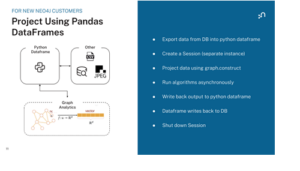
(Titima Ongkantong/Shutterstock)
Neo4j this week launched Aura Graph Analytics, a new offering designed to lower the barrier to using powerful graph algorithms. Neo4j says Aura Graph Analytics is a serverless service that brings 65 graph algorithms to bear on data wherever it resides, including relational databases, all the major clouds, as well as Databricks and (soon) Snowflake, without resorting to complex ETL. But how does it manage this trick?
Neo4j is well-respected pioneer in the field of graph databases, which are a type of highly structured NoSQL database that organizes data as nodes and edges. This graph approach allows users to relatively easily discover connections buried in data that would ordinarily take highly complex queries and enormous compute power to uncover using traditional relational database technology.
In addition to its core database, which is typically used for a mix of transactional and analytical workloads like fraud detection and product recommendations, Neo4j also develops a series of algorithms designed to take advantage of connected data. It has sold these graph algorithms, which are used primarily for data science use cases, under Neo4j for Graph Data Science name since it initially launched it back in April 2020 with 48 graph algos and updated two years later.
With those two first releases of the Neo4j GDS product, customers needed to have a Neo4j database to run the graph algorithms upon. With this week’s launch of Neo4j Aura Graph Analytics, that requirement has been eliminated (although customers can also run it on a Neo4j database). Today, customers can run the fine-tuned Neo4j graph algos on data residing in other data platforms through the new Graph Analytics Python client.

Neo4j offers a new Python client that streams a “projection” of data from its source into Aura Graph Analytics (Image courtesy Neo4j)
According to Neo’s technical notes, the new Python client API is designed to mimic the GDS Cypher procedure API in Python code, specifically as a Pandas dataframe. From the Python client installed on the remote data platform, Neo4j says it will “project” data into the Aura Graph Analytics service that Neo4j runs on behalf of its clients.
What exactly is it projecting? According to Neo4j, these “projections” are “optimized in-memory representations” that the graph algorithms can consume within Aura Graph Analytics service. “The data that is sent retains the required information for a user to run graph algorithms,” the company tells BigDATAwire. In this manner, Neo4j gets around the need to build and maintain ETL pipelines.
How much more efficient is the projection of data for the optimized in-memory representations versus a full batch data dump via ETL? It’s hard to tell. A Neo4j spokesperson tells us:
“It depends because it varies by specific use case. Traditionally, an ETL pipeline needs to be set up before analytics can be run. However, Aura Graph Analytics enables you to simply query the original source in place, and it will retrieve only the data needed to create that specific projection. Not needing to have an ETL pipeline or persistent storage makes it extremely simple to get up and running immediately to experiment, with a seamless transition to production.”
Of course, customers can also use Aura Graph Analytics with their Neo4j database, in which case they would connect the graph algorithms to the data directly using Cypher, Neo4j’s data access language. But if customers don’t have a Neo4j instance and don’t to set them up, they can still partake of the bounty of Neo4j’s 65-plus fine-tuned graph algorithms without ETLing their data out of Oracle and SQL Server databases or any cloud data warehouse or data lake, including Google BigQuery, Microsoft OneLake, and Databricks. Support for Snowflake is due in the third quarter, the company says.
Aura Graph Analytics includes an array of pre-built graph algorithms for a range of uses, including fraud detection, anti-money laundering, disease contact tracing, customer 360, supply chain management, recommendation engines, and social network analysis.
“Our vision with Aura Graph Analytics is simple: make it easy for any user to make better business decisions faster,” said Sudhir Hasbe, chief product officer for Neo4j. “By removing hurdles like complex queries, ETL, and costly infrastructure set-up, organizations can tap into the full power of graph analytics without needing to be graph experts. The result: better decisions on any enterprise data source, built on a deeper understanding of how everything connects.”
Early adopters have been running Aura Graph Analytics for some time. One customer, the tax software provider Intuit, is using Neo4j Aura graph algorithms to protect its network infrastructure. According to Neo4j, Intuit is using Aura Graph Analytics to “attribute 500,000+ endpoints to host names in milliseconds, enabling rapid responses to zero-day vulnerabilities.”
Similarly, BNP Paribas Personal Finance is using Neo4j Aura Graph Analytics to run a fraud detection system. Neo4j says BNP Paribas’ fraud detection system can identify fraud patterns in less than two seconds and has reduced the instance of fraud at the bank by 20%.
Pricing for Aura Graph Analytics is $0.40 per GB of RAM per hour, with a minimum of 10 minutes for all billable events. Neo4j says that data in Aura Graph Analytics is only held in memory for the duration of the session for the algorithms to run and is not stored to disk.
Related Items:
Neo4j Drives Simplicity with Graph Data Science Refresh
Neo4j Releases the Next Generation of Its Graph Database
Neo4j Brings Graph Database and Data Science Together


